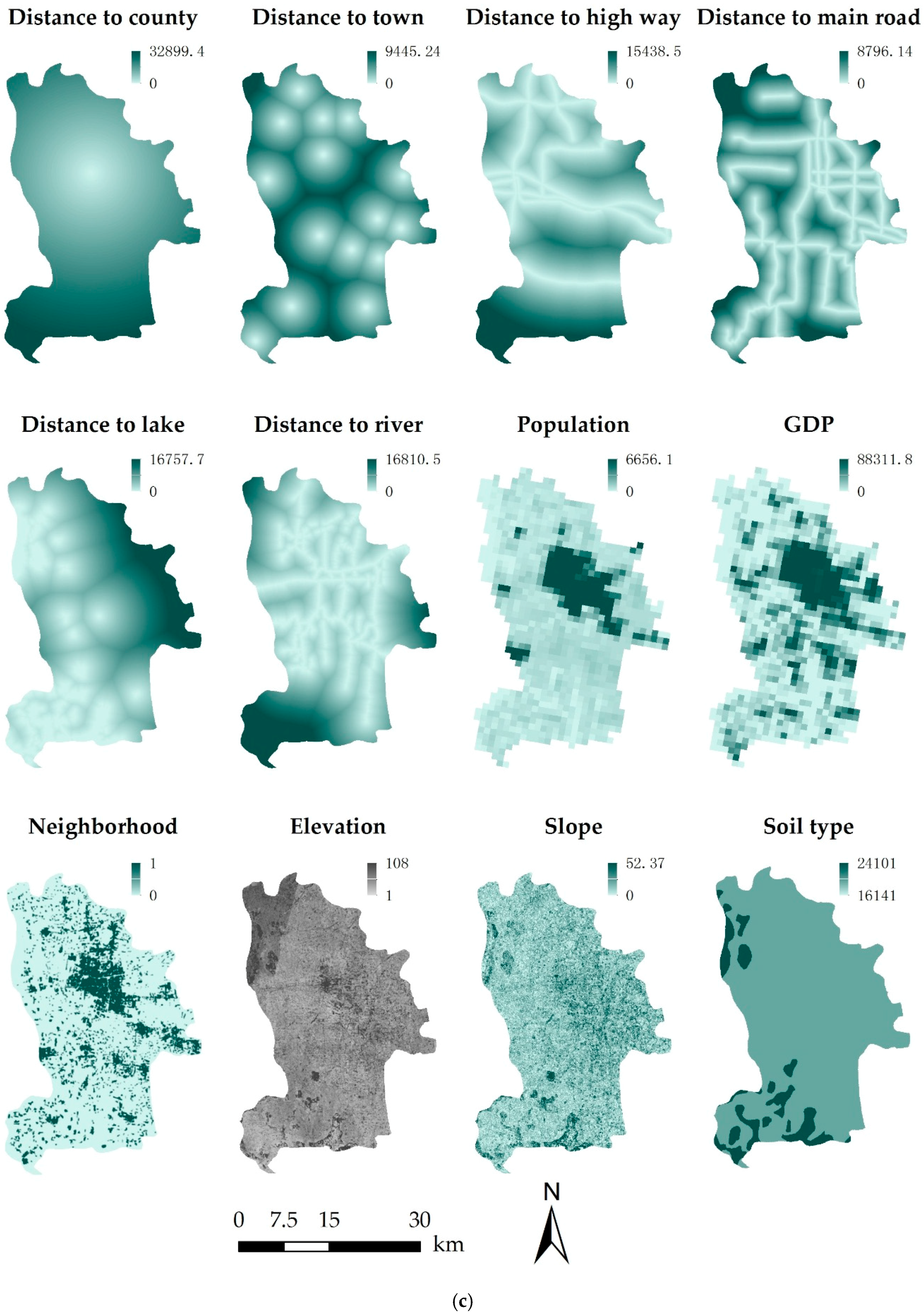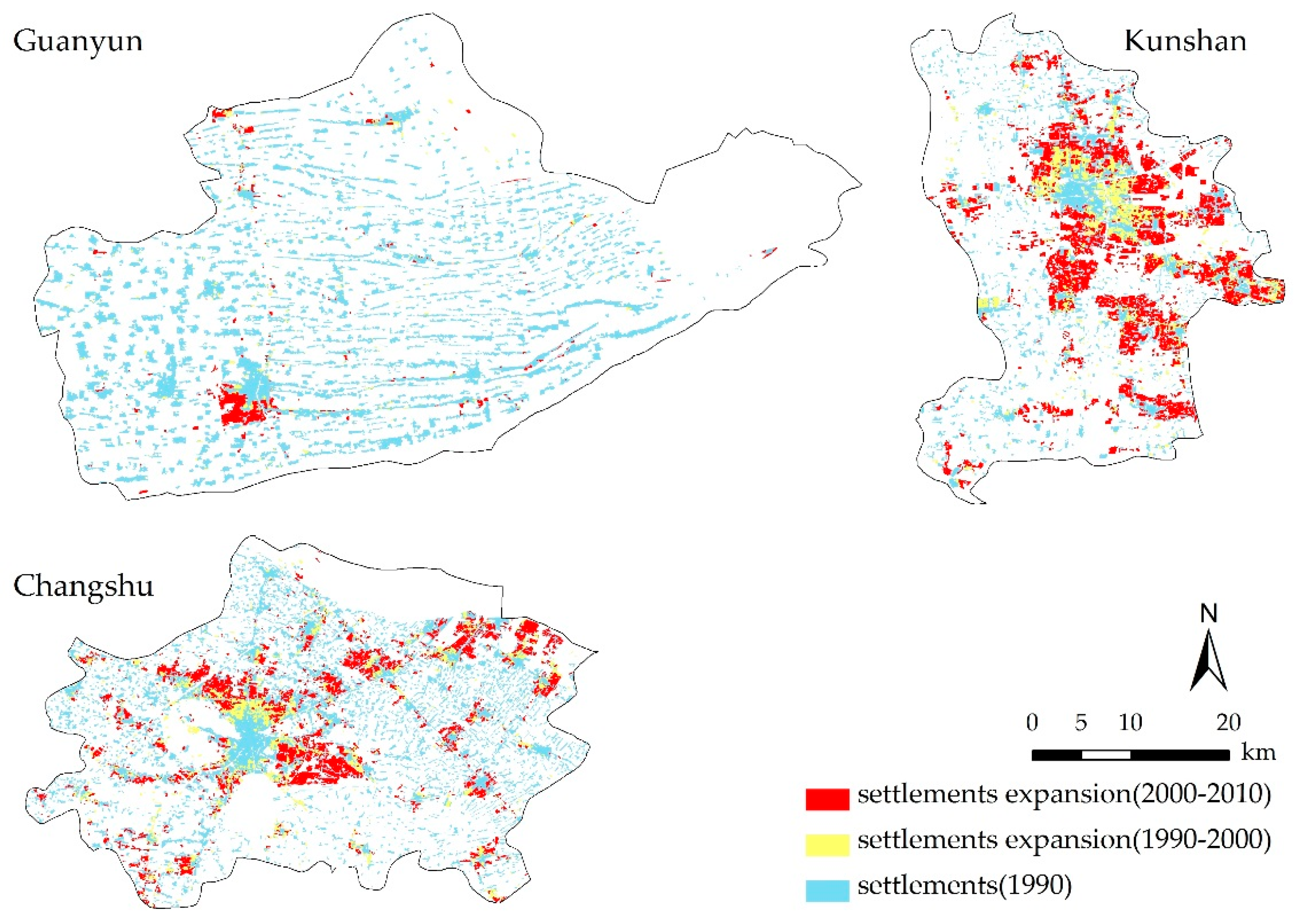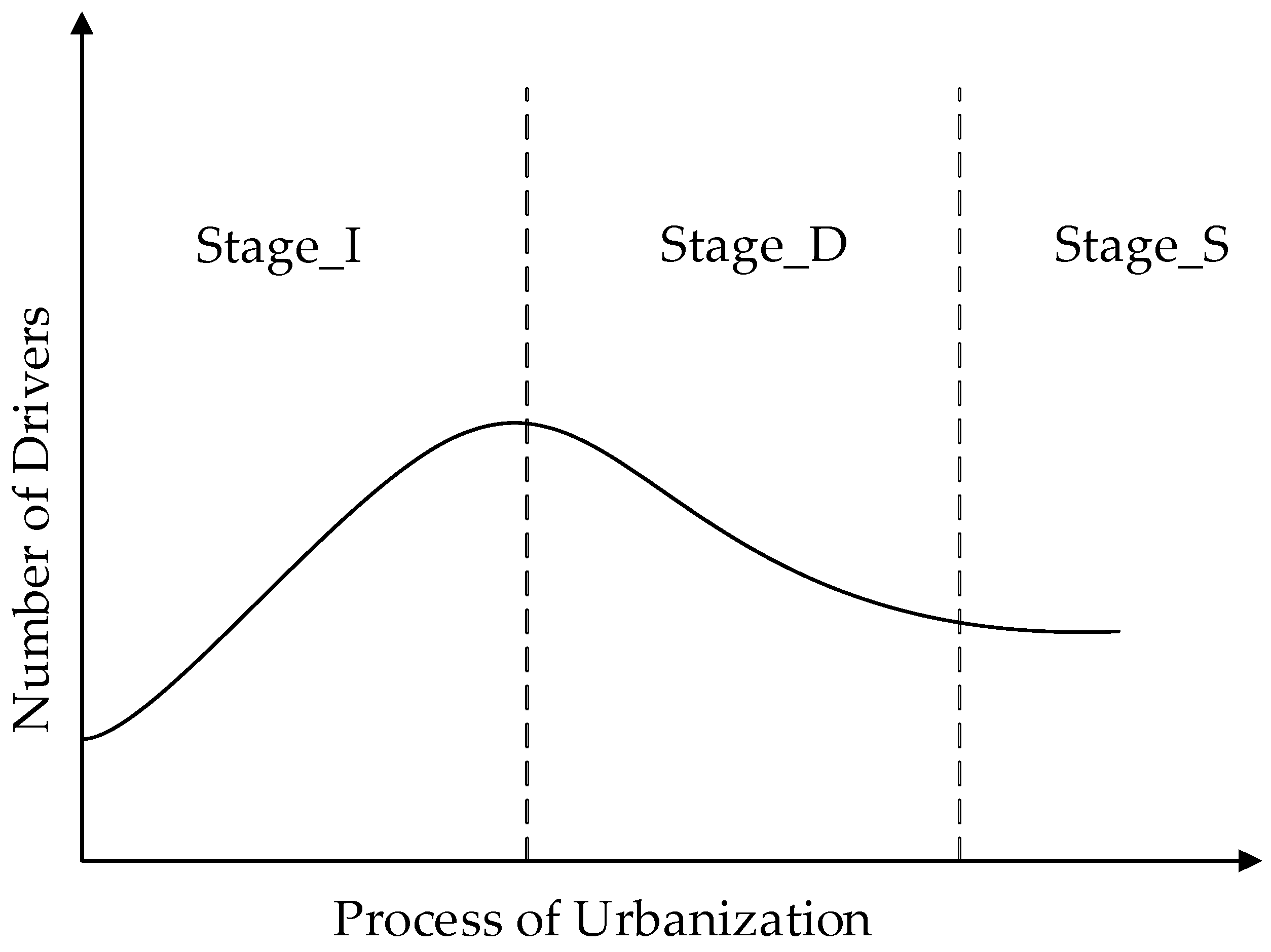Spatiotemporal Variation of Driving Forces for Settlement Expansion in Different Types of Counties
Abstract
:1. Introduction
2. Study Area and Data Sources
2.1. Study Area

2.2. Data Sources
3. Methods
3.1. The Interpretation of Settlements
3.2. Generating Land Use Maps
3.3. Potential Driving Forces
| Category | Variables | Description |
|---|---|---|
| Physical factors | Elevation | |
| Slope | ||
| Soil type | ||
| Socioeconomic factors | Population | The amount of population per cell |
| GDP | GDP within per cell | |
| Accessibility factors | D_river | Distance to river |
| D_lake | Distance to lake | |
| D_county | Distance to county center | |
| D_town | Distance to town center | |
| D_hway | Distance to highway | |
| D_mroad | Distance to main road | |
| Neighborhood factors | P_settlement | Proportion of settlements area within a 210 m window |


3.3.1. Physical Factors
3.3.2. Socioeconomic Factors
3.3.3. Accessibility Factors
3.3.4. Neighborhood Factors
3.4. Spatial Sampling
3.5. Binary Logistic Regression
4. Results
4.1. Spatiotemporal Settlements Expansion

| Year | Percent | Time Period | Annual Expansion (km/a) | ||||
|---|---|---|---|---|---|---|---|
| Guanyun | Kunshan | Changshu | Guanyun | Kunshan | Changshu | ||
| 1990 | 13.59% | 11.60% | 16.96% | - | - | - | - |
| 2000 | 14.06% | 15.93% | 20.25% | 1990–2000 | 0.88 | 4.13 | 3.98 |
| 2010 | 14.98% | 29.40% | 27.51% | 2000–2010 | 1.71 | 12.84 | 8.79 |
4.2. Spatiotemporal Features of Driving Forces
| Town | Guanyun | Kunshan | Changshu | |||
|---|---|---|---|---|---|---|
| Period | 1990–2000 | 2000–2010 | 1990–2000 | 2000–2010 | 1990–2000 | 2000–2010 |
| Constant | 0.392 ** | 0.14 ** | 0.244 ** | −0.031 ** | 0.169 ** | −0.066 ** |
| Elevation | - | - | 0.351 ** | −0.186 ** | - | - |
| Slope | - | - | - | - | −0.284 ** | - |
| Soil type | - | 0.356 ** | −0.25 ** | - | - | - |
| Pop | 1.453 ** | 1.127 ** | 1.085 ** | 0.24 ** | 0.911 ** | - |
| GDP | - | - | 0.907 ** | 0.572 ** | 0.695 ** | 0.886 ** |
| D_river | - | 0.34** | - | - | 0.256 ** | - |
| D_lake | - | - | - | 0.2 ** | −0.32 ** | −0.192 ** |
| D_county | - | - | - | −0.404 ** | −0.374 ** | - |
| D_town | −0.552 ** | −1.125 ** | - | −0.379 ** | - | −0.484 ** |
| D_hway | - | −0.679 ** | −0.337 ** | - | −0.427 ** | - |
| D_mroad | - | - | −0.677 ** | −0.586 ** | −0.506 ** | −0.81 ** |
| Neighborhood | 1.326 ** | 0.937 ** | 0.551 ** | - | 0.244 ** | 0.453 ** |
| N | 234 | 430 | 716 | 2070 | 690 | 1416 |
| PCP | 82.1 | 79.8 | 80.6 | 73.9 | 77.5 | 76.8 |
| AUC | 0.873 | 0.881 | 0.874 | 0.774 | 0.85 | 0.839 |
| R2 | 0.501 | 0.546 | 0.526 | 0.351 | 0.452 | 0.434 |
| Town | Guanyun | Kunshan | Changshu | |||
|---|---|---|---|---|---|---|
| Period | 1990–2000 | 2000–2010 | 1990–2000 | 2000–2010 | 1990–2000 | 2000–2010 |
| Elevation | 5 | 7 | ||||
| Slope | 7 | |||||
| Soil type | 5 | 7 | ||||
| Pop | 1 | 1 | 1 | 5 | 1 | |
| GDP | 2 | 2 | 2 | 1 | ||
| D_river | 6 | 8 | ||||
| D_lake | 6 | 6 | 5 | |||
| D_county | 3 | 5 | ||||
| D_town | 3 | 2 | 4 | 3 | ||
| D_hway | 4 | 6 | 4 | |||
| D_mroad | 3 | 1 | 3 | 2 | ||
| Neighborhood | 2 | 3 | 4 | 9 | 4 | |
4.2.1. Temporal Differences
4.2.2. Spatial Differences
| Town | 1990–2000 | 2000–2010 | ||||
|---|---|---|---|---|---|---|
| Period | Guanyun | Kunshan | Changshu | Guanyun | Kunshan | Changshu |
| Elevation | 5 | 7 | ||||
| Slope | 7 | |||||
| Soil type | 7 | 5 | ||||
| Pop | 1 | 1 | 1 | 1 | 5 | |
| GDP | 2 | 2 | 2 | 1 | ||
| D_river | 8 | 6 | ||||
| D_lake | 6 | 6 | 5 | |||
| D_county | 5 | 3 | ||||
| D_town | 3 | 2 | 4 | 3 | ||
| D_hway | 6 | 4 | 4 | |||
| D_mroad | 3 | 3 | 1 | 2 | ||
| Neighborhood | 2 | 4 | 9 | 3 | 4 | |
5. Discussion
5.1. The Discrepancy of Settlement Expansion among Different Types of Counties
5.2. The Discrepancy of Drivers among Different Types of Counties
5.2.1. Changes in the Number of Drivers

5.2.2. The Change in the Relative Importance of Drivers
5.3. Management and Policy Implications
6. Conclusions
Acknowledgments
Author Contributions
Conflicts of Interest
References
- Seto, K.C.; Fragkias, M.; Güneralp, B.; Reilly, M.K. A meta-analysis of global urban land expansion. PLoS ONE 2011, 6, 1–9. [Google Scholar] [CrossRef] [PubMed]
- Wei, Y.; Zhang, Z. Assessing the fragmentation of construction land in urban areas: An index method and case study in Shunde, China. Land Use Pol. 2012, 29, 417–428. [Google Scholar] [CrossRef]
- Liu, L.; Xu, X.; Chen, X. Assessing the impact of urban expansion on potential crop yield in China during 1990–2010. Food Secur. 2015, 7, 33–43. [Google Scholar] [CrossRef]
- Rosenfeld, D. Suppression of rain and snow by urban and industrial air pollution. Science 2000, 287, 1793–1796. [Google Scholar] [CrossRef] [PubMed]
- Hansen, A.J.; Knight, R.L.; Marzluff, J.M.; Powell, S.; Brown, K.; Gude, P.H.; Jones, K. Effects of exurban development on biodiversity: Patterns, mechanisms, and research needs. Ecol. Appl. 2005, 15, 1893–1905. [Google Scholar] [CrossRef]
- Kuang, W.; Liu, J.; Zhang, Z.; Lu, D.; Xiang, B. Spatiotemporal dynamics of impervious surface areas across China during the early 21st century. Chin. Sci. Bull. 2013, 58, 1691–1701. [Google Scholar] [CrossRef]
- Su, S.; Zhang, Q.; Zhang, Z.; Zhi, J.; Wu, J. Rural settlement expansion and paddy soil loss across an ex-urbanizing watershed in eastern coastal China during market transition. Reg. Environ. Chang. 2011, 11, 651–662. [Google Scholar] [CrossRef]
- Lin, G.C.; Ho, S.P. China‘s land resources and land-use change: Insights from the 1996 land survey. Land Use Pol. 2003, 20, 87–107. [Google Scholar] [CrossRef]
- Song, W.; Pijanowski, B.C.; Tayyebi, A. Urban expansion and its consumption of high-quality farmland in Beijing, China. Ecol. Indic. 2015, 54, 60–70. [Google Scholar] [CrossRef]
- Xie, H.; Zou, J.; Jiang, H.; Zhang, N.; Choi, Y. Spatiotemporal pattern and driving forces of arable land-use intensity in China: Toward sustainable land management using emergy analysis. Sustainability 2014, 6, 3504–3520. [Google Scholar] [CrossRef]
- Seto, K.C.; Fragkias, M. Quantifying spatiotemporal patterns of urban land-use change in four cities of China with time series landscape metrics. Landsc. Ecol. 2005, 20, 871–888. [Google Scholar] [CrossRef]
- Tan, R.; Liu, Y.; Liu, Y.; He, Q.; Ming, L.; Tang, S. Urban growth and its determinants across the Wuhan urban agglomeration, central China. Habitat Int. 2014, 44, 268–281. [Google Scholar] [CrossRef]
- Tan, M.; Li, X.; Xie, H.; Lu, C. Urban land expansion and arable land loss in China—A case study of Beijing–Tianjin–Hebei region. Land Use Pol. 2005, 22, 187–196. [Google Scholar] [CrossRef]
- Li, X.; Zhou, W.; Ouyang, Z. Forty years of urban expansion in Beijing: What is the relative importance of physical, socioeconomic, and neighborhood factors? Appl. Geogr. 2013, 38, 1–10. [Google Scholar] [CrossRef]
- Du, X.; Jin, X.; Yang, X.; Yang, X.; Zhou, Y. Spatial pattern of land use change and its driving force in Jiangsu province. Int. J. Environ. Res. Public Health 2014, 11, 3215–3232. [Google Scholar] [CrossRef] [PubMed]
- Chen, M.; Ye, C. Differences in Pattern and Driving Forces between Urban and Rural Settlements in the Coastal Region of Ningbo, China. Sustainability 2014, 6, 1848–1867. [Google Scholar] [CrossRef]
- Chen, J.; Chang, K.; Karacsonyi, D.; Zhang, X. Comparing urban land expansion and its driving factors in Shenzhen and Dongguan, China. Habitat Int. 2014, 43, 61–71. [Google Scholar] [CrossRef]
- Tian, L.; Chen, J.; Yu, S.X. Coupled dynamics of urban landscape pattern and socioeconomic drivers in Shenzhen, China. Landsc. Ecol. 2014, 29, 715–727. [Google Scholar] [CrossRef]
- Tian, G.; Wu, J. Comparing urbanization patterns in Guangzhou of China and Phoenix of the USA: The influences of roads and rivers. Ecol. Indic. 2015, 52, 23–30. [Google Scholar] [CrossRef]
- Yu, X.; Zhang, A.; Hou, X.; Li, M.; Xia, Y. Multi-temporal remote sensing of land cover change and urban sprawl in the coastal city of Yantai, China. Int. J. Digit. Earth 2013, 6 (Suppl. 2), 137–154. [Google Scholar] [CrossRef]
- Tian, G.; Qiao, Z.; Gao, X. Rural settlement land dynamic modes and policy implications in Beijing metropolitan region, China. Habitat Int. 2014, 44, 237–246. [Google Scholar] [CrossRef]
- Yang, R.; Liu, Y.; Long, H.; Qiao, L. Spatio-temporal characteristics of rural settlements and land use in the Bohai Rim of China. J. Geogr. Sci. 2015, 25, 559–572. [Google Scholar] [CrossRef]
- Liu, Y.; Luo, T.; Liu, Z.; Kong, X.; Li, J.; Tan, R. A comparative analysis of urban and rural construction land use change and driving forces: Implications for urban–rural coordination development in Wuhan, Central China. Habitat Int. 2015, 47, 113–125. [Google Scholar] [CrossRef]
- Xu, Y.; Pu, L.; Zhang, L. Spatial pattern and the process of settlement expansion in Jiangsu Province from 1980 to 2010, Eastern China. Sustainability 2014, 6, 8180–8194. [Google Scholar] [CrossRef]
- Shu, B.; Zhang, H.; Li, Y.; Qu, Y.; Chen, L. Spatiotemporal variation analysis of driving forces of urban land spatial expansion using logistic regression: A case study of port towns in Taicang City, China. Habitat Int. 2014, 43, 181–190. [Google Scholar] [CrossRef]
- Zhu, F.; Zhang, F.; Li, C.; Zhu, T. Functional transition of the rural settlement: Analysis of land-use differentiation in a transect of Beijing, China. Habitat Int. 2014, 41, 262–271. [Google Scholar] [CrossRef]
- Long, H.; Li, Y.; Liu, Y.; Woods, M.; Zou, J. Accelerated restructuring in rural China fueled by ‘increasing vs. decreasing balance’land-use policy for dealing with hollowed villages. Land Use Pol. 2012, 29, 11–22. [Google Scholar] [CrossRef]
- Long, H.; Zou, J.; Liu, Y. Differentiation of rural development driven by industrialization and urbanization in eastern coastal China. Habitat Int. 2009, 33, 454–462. [Google Scholar] [CrossRef]
- Xi, J.; Zhao, M.; Ge, Q.; Kong, Q. Changes in land use of a village driven by over 25 years of tourism: The case of Gougezhuang village, China. Land Use Pol. 2014, 40, 119–130. [Google Scholar] [CrossRef]
- Liu, Y.; Yang, R.; Long, H.; Gao, J.; Wang, J. Implications of land-use change in rural China: A case study of Yucheng, Shandong province. Land Use Pol. 2014, 40, 111–118. [Google Scholar] [CrossRef]
- Xi, J.; Wang, X.; Kong, Q.; Zhang, N. Spatial morphology evolution of rural settlements induced by tourism. J. Geogr. Sci. 2015, 25, 497–511. [Google Scholar] [CrossRef]
- Tian, G.; Qiao, Z.; Zhang, Y. The investigation of relationship between rural settlement density, size, spatial distribution and its geophysical parameters of China using Landsat TM images. Ecol. Model. 2012, 231, 25–36. [Google Scholar] [CrossRef]
- Xu, E.; Zhang, H. Characterization and interaction of driving factors in karst rocky desertification: A case study from Changshun, China. Solid Earth Discuss. 2014, 6, 2939–2969. [Google Scholar] [CrossRef]
- Zhang, Z.; Su, S.; Xiao, R.; Jiang, D.; Wu, J. Identifying determinants of urban growth from a multi-scale perspective: A case study of the urban agglomeration around Hangzhou Bay, China. Appl. Geogr. 2013, 45, 193–202. [Google Scholar] [CrossRef]
- Xiao, R.; Su, S.; Mai, G.; Zhang, Z.; Yang, C. Quantifying determinants of cash crop expansion and their relative effects using logistic regression modeling and variance partitioning. Int. J. Appl. Earth Obs. 2015, 34, 258–263. [Google Scholar] [CrossRef]
- Luo, J.; Wei, Y.D. Modeling spatial variations of urban growth patterns in Chinese cities: the case of Nanjing. Landsc. Urban Plan. 2009, 91, 51–64. [Google Scholar] [CrossRef]
- Shafizadeh-Moghadam, H.; Helbich, M. Spatiotemporal variability of urban growth factors: A global and local perspective on the megacity of Mumbai. Int. J. Appl. Earth Obs. 2015, 35, 187–198. [Google Scholar] [CrossRef]
- Kuang, W.; Chi, W.; Lu, D.; Dou, Y. A comparative analysis of megacity expansions in China and the US: Patterns, rates and driving forces. Landsc. Urban Plan. 2014, 132, 121–135. [Google Scholar] [CrossRef]
- Su, S.; Xiao, R.; Li, D. Impacts of transportation routes on landscape diversity: A comparison of different route types and their combined effects. Environ. Manag. 2014, 53, 636–647. [Google Scholar] [CrossRef] [PubMed]
- Müller, K.; Steinmeier, C.; Küchler, M. Urban growth along motorways in Switzerland. Landsc. Urban Plan. 2010, 98, 3–12. [Google Scholar] [CrossRef]
- Liu, H.; Zhou, Q. Developing urban growth predictions from spatial indicators based on multi-temporal images. Comput. Environ. Urban Syst. 2005, 29, 580–594. [Google Scholar] [CrossRef]
- Cheng, J.; Masser, I. Urban growth pattern modeling: A case study of Wuhan city, PR China. Landsc. Urban Plan. 2003, 62, 199–217. [Google Scholar] [CrossRef]
- Hu, Z.; Lo, C. Modeling urban growth in Atlanta using logistic regression. Comput. Environ. Urban Syst. 2007, 31, 667–688. [Google Scholar] [CrossRef]
- Menard, S. Applied Logistic Regression Analysis; Sage: Thousand Oaks, CA, USA, 2002; Volume 106. [Google Scholar]
- Menard, S. Six approaches to calculating standardized logistic regression coefficients. Am. Stat. 2012, 58, 218–223. [Google Scholar] [CrossRef]
- Tan, M.; Li, X. The changing settlements in rural areas under urban pressure in China: Patterns, driving forces and policy implications. Landsc. Urban Plan. 2013, 120, 170–177. [Google Scholar] [CrossRef]
- Long, H.; Liu, Y.; Wu, X.; Dong, G. Spatio-temporal dynamic patterns of farmland and rural settlements in Su–Xi–Chang region: Implications for building a new countryside in coastal China. Land Use Pol. 2009, 26, 322–333. [Google Scholar] [CrossRef]
- Deng, X.; Huang, J.; Rozelle, S.; Uchida, E. Growth, population and industrialization, and urban land expansion of China. J. Urban Econ. 2008, 63, 96–115. [Google Scholar] [CrossRef]
- Kuang, W.; Liu, J.; Dong, J.; Chi, W.; Zhang, C. The rapid and massive urban and industrial land expansions in China between 1990 and 2010: A CLUD-based analysis of their trajectories, patterns, and drivers. Landsc. Urban Plan. 2016, 145, 21–33. [Google Scholar] [CrossRef]
- Huang, B.; Zhang, L.; Wu, B. Spatiotemporal analysis of rural–urban land conversion. Int. J. Geogr. Inform. Sci. 2009, 23, 379–398. [Google Scholar] [CrossRef]
- Braimoh, A.K.; Onishi, T. Spatial determinants of urban land use change in Lagos, Nigeria. Land Use Pol. 2007, 24, 502–515. [Google Scholar] [CrossRef]
© 2015 by the authors; licensee MDPI, Basel, Switzerland. This article is an open access article distributed under the terms and conditions of the Creative Commons by Attribution (CC-BY) license (http://creativecommons.org/licenses/by/4.0/).
Share and Cite
Dong, G.; Xu, E.; Zhang, H. Spatiotemporal Variation of Driving Forces for Settlement Expansion in Different Types of Counties. Sustainability 2016, 8, 39. https://doi.org/10.3390/su8010039
Dong G, Xu E, Zhang H. Spatiotemporal Variation of Driving Forces for Settlement Expansion in Different Types of Counties. Sustainability. 2016; 8(1):39. https://doi.org/10.3390/su8010039
Chicago/Turabian StyleDong, Guanglong, Erqi Xu, and Hongqi Zhang. 2016. "Spatiotemporal Variation of Driving Forces for Settlement Expansion in Different Types of Counties" Sustainability 8, no. 1: 39. https://doi.org/10.3390/su8010039
APA StyleDong, G., Xu, E., & Zhang, H. (2016). Spatiotemporal Variation of Driving Forces for Settlement Expansion in Different Types of Counties. Sustainability, 8(1), 39. https://doi.org/10.3390/su8010039






